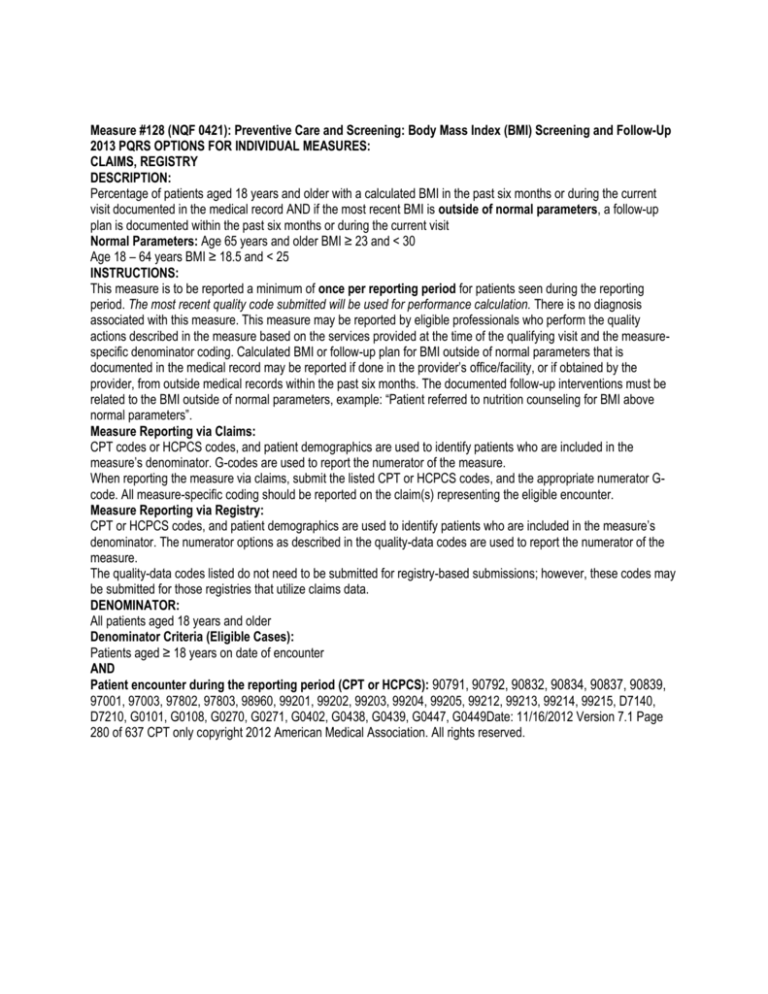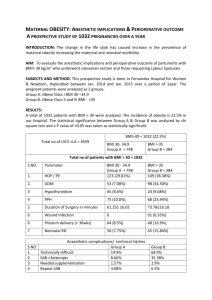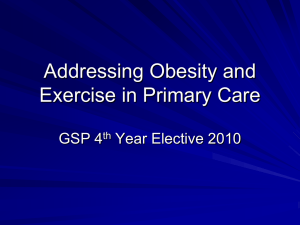
Measure #128 (NQF 0421): Preventive Care and Screening: Body Mass Index (BMI) Screening and Follow-Up
2013 PQRS OPTIONS FOR INDIVIDUAL MEASURES:
CLAIMS, REGISTRY
DESCRIPTION:
Percentage of patients aged 18 years and older with a calculated BMI in the past six months or during the current
visit documented in the medical record AND if the most recent BMI is outside of normal parameters, a follow-up
plan is documented within the past six months or during the current visit
Normal Parameters: Age 65 years and older BMI ≥ 23 and < 30
Age 18 – 64 years BMI ≥ 18.5 and < 25
INSTRUCTIONS:
This measure is to be reported a minimum of once per reporting period for patients seen during the reporting
period. The most recent quality code submitted will be used for performance calculation. There is no diagnosis
associated with this measure. This measure may be reported by eligible professionals who perform the quality
actions described in the measure based on the services provided at the time of the qualifying visit and the measurespecific denominator coding. Calculated BMI or follow-up plan for BMI outside of normal parameters that is
documented in the medical record may be reported if done in the provider’s office/facility, or if obtained by the
provider, from outside medical records within the past six months. The documented follow-up interventions must be
related to the BMI outside of normal parameters, example: “Patient referred to nutrition counseling for BMI above
normal parameters”.
Measure Reporting via Claims:
CPT codes or HCPCS codes, and patient demographics are used to identify patients who are included in the
measure’s denominator. G-codes are used to report the numerator of the measure.
When reporting the measure via claims, submit the listed CPT or HCPCS codes, and the appropriate numerator Gcode. All measure-specific coding should be reported on the claim(s) representing the eligible encounter.
Measure Reporting via Registry:
CPT or HCPCS codes, and patient demographics are used to identify patients who are included in the measure’s
denominator. The numerator options as described in the quality-data codes are used to report the numerator of the
measure.
The quality-data codes listed do not need to be submitted for registry-based submissions; however, these codes may
be submitted for those registries that utilize claims data.
DENOMINATOR:
All patients aged 18 years and older
Denominator Criteria (Eligible Cases):
Patients aged ≥ 18 years on date of encounter
AND
Patient encounter during the reporting period (CPT or HCPCS): 90791, 90792, 90832, 90834, 90837, 90839,
97001, 97003, 97802, 97803, 98960, 99201, 99202, 99203, 99204, 99205, 99212, 99213, 99214, 99215, D7140,
D7210, G0101, G0108, G0270, G0271, G0402, G0438, G0439, G0447, G0449Date: 11/16/2012 Version 7.1 Page
280 of 637 CPT only copyright 2012 American Medical Association. All rights reserved.
NUMERATOR:
Patients with BMI calculated within the past six months or during the current visit, and a follow-up plan documented
within the past six months or during the current visit if the BMI is outside of normal parameters
Definitions:
BMI – Body mass index (BMI), is expressed as weight/height (kg/m2) and is commonly used to classify weight
categories.
Calculated BMI – Requires an eligible professional or their staff to measure both the height and weight. Selfreported values cannot be used. BMI is calculated either as weight in pounds divided by height in inches squared
multiplied by 703, or as weight in kilograms divided by height in meters squared.
Follow-Up Plan – Proposed outline of treatment to be conducted as a result of a BMI out of normal parameters.
Such follow-up may include but is not limited to: documentation of a future appointment, education, referral (such as,
a registered dietician, nutritionist, occupational therapist, physical therapist, primary care provider, exercise
physiologist, mental health professional, or surgeon), pharmacological interventions, dietary supplements, exercise
counseling, or nutrition counseling.
Not Eligible/Not Appropriate for BMI Measurement or Follow-Up Plan – A patient is not eligible if one or more of
the following reasons exists:
• Patient is receiving palliative care
• Patient is pregnant
• Patient refuses BMI measurement
• If there is any other reason documented in the medical record by the provider explaining why BMI measurement or
follow-up plan was not appropriate
• Patient is in an urgent or emergent medical situation where time is of the essence, and to delay treatment would
jeopardize the patient’s health status.
Numerator Quality-Data Coding Options for Reporting Satisfactorily:
BMI Calculated as Normal, No Follow-Up Plan Required
(One G-code [G84xx] is required on the claim form to submit this numerator option)
G8420: Calculated BMI within normal parameters and documented
OR
BMI Calculated Above Normal Parameters, Follow-Up Documented
G8417: Calculated BMI above normal parameters and a follow-up plan was documented
OR
BMI Calculated Below Normal Parameters, Follow-Up Documented
G8418: Calculated BMI below normal parameters and a follow-up plan was documented
OR
BMI not Calculated, Patient not Eligible/not Appropriate
(One G-code [G8422 or G8938] is required on the claim form to submit this numerator option)
G8422: Patient not eligible for BMI calculation
OR
BMI Calculated, Patient not Eligible/not Appropriate for Follow-up Plan
G8938: BMI is calculated, but patient not eligible for follow-up plan
OR
BMI not Calculated, Reason not Given
(One G-code [G84xx] is required on the claim form to submit this numerator option)
G8421: BMI not calculated
OR
BMI Calculated Outside Normal Parameters, Follow-Up Plan not Documented, Reason not Given
G8419: Calculated BMI outside normal parameters, no follow-up plan documented Date: 11/16/2012 Version 7.1
Page 281 of 637 CPT only copyright 2012 American Medical Association. All rights reserved.
RATIONALE:
BMI Above Upper Parameters
“In 2009, no state met the healthy people 2012 obesity target of 15 percent, and the self reported overall prevalence
of obesity among U.S. adults had increased 1.1 percentage points from 2007. Overall self-reported obesity
prevalence in the U.S. was 26.7 percent” (CDC, 2010).
Obesity continues to be a public health concern in the United States and throughout the world. In the United States,
obesity prevalence doubled among adults between 1980 and 2004 (Flegal et al., 2002; Ogden et al., 2006). Obesity
is associated with increased risk of a number of conditions, including diabetes mellitus, cardiovascular disease,
hypertension, and certain cancers, as well as with increased risk of disability and a modestly elevated risk of allcause mortality. “Obesity is associated with an increased risk of death, particularly in adults younger than age 65
years. Obesity has been shown to reduce life expectancy by 6 to 20 years depending on age and race. Ischemic
heart disease, diabetes, cancer (especially liver, kidney, breast, endometrial, prostate and colon), and respiratory
diseases are the leading causes of death in persons who are obese” (AHRQ, 2011).
Results from the 2009-2010 National Health and Nutrition Examination Survey (NHANES) indicate that an estimated
35.7 percent of adults are obese (NCHS, CDC, 2012). Although the prevalence of adults in the U.S. who are obese is
still high with about one-third of adults obese in 2007-2008, data suggest that the rate of increase for obesity in the
U.S. in recent decades may be slowing (Flegal et al., 2010).
Finkelstein et al. (2009) found that across all payers, per capita medical spending for the obese is $1,429 higher per
year, or roughly 42 percent higher than for someone of normal weight. In aggregate, the annual medical burden of
obesity has increased from 6.5 percent to 9.1 percent of annual medical spending and could be as high as $147
billion per year (in 2008 dollars). A study by Tsai et al. (2010) estimated cost for obesity to be even higher. A recent
study by Cawley et al. (2012) reported findings that indicate that the effect of obesity of medical care cost is much
greater than previously appreciated.
Ma et al. (2009) performed a retrospective, cross-sectional analysis of ambulatory visits in the National Ambulatory
Medical Care Survey from 2005 and 2006. The study findings on obesity and office-based quality of care concluded
the evidence is compelling and that obesity is underappreciated in office-based physician practices across the United
States. Many opportunities are missed for obesity screening and diagnosis, as well as for the prevention and
treatment of obesity and related health risks, regardless of patient and provider characteristics.
BMI Below Normal Parameters
Poor nutrition or underlying health conditions can result in underweight. Results from the 2007-2008 National Health
and Nutrition Examination Survey (CDC, 2010), using measured heights and weights, indicate an estimated 1.6% of
U.S. adults are underweight with women more likely to be underweight than men.
Huffman (2002) states elderly patients with unintentional weight loss are at higher risk for infection, depression and
death. The leading causes of involuntary weight loss are depression (especially in residents of long-term care
facilities), cancer (lung and gastrointestinal malignancies), cardiac disorders and benign gastrointestinal diseases.
Medications that may cause nausea and vomiting, dysphagia, dysgeusia and anorexia have been implicated.
Polypharmacy can cause unintended weight loss, as can psychotropic medication reduction (e.g., by unmasking
problems such as anxiety). In an observational study, Ranhoff et al. (2005) recommended using BMI < 23 for the
elderly to identify positive results with malnutrition screens and poor nutritional status.Date: 11/16/2012 Version 7.1
Page 282 of 637 CPT only copyright 2012 American Medical Association. All rights reserved.
CLINICAL RECOMMENDATION STATEMENTS:
Although multiple clinical recommendations addressing obesity have been developed by professional organizations,
societies and associations, two recommendations have been identified which exemplify the intent of the measure and
address the numerator and denominator.
The US Preventive Health Services Task Force (USPSTF) The Guide to Clinical Preventive Services, 2010-2011
recommends that clinicians screen all adult patients for obesity and offer intensive counseling and behavioral
interventions to promote sustained weight loss for obese adults (Level Evidence B).
Institute for Clinical Systems Improvement (ICSI, 2011) Prevention and Management of Obesity (Mature Adolescents
and Adults) provides the following guidance:
• Calculate the body mass index; classify the individual based on the body mass index categories. Educate patients
about their body mass index and their associated risks.
• Weight management requires a team approach. Be aware of clinical and community resources. The patient needs
to have an ongoing therapeutic relationship and follow-up with a health care team.
• Weight control is a lifelong commitment, and the health care team can assist with setting specific goals with the
patient.










